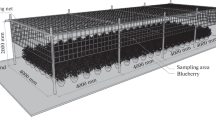Abstract
Morphological responses of American cranberry (Vacciniummacrocarpon Ait, Ericaceae) to different light conditions (red,far-red, white light and sunlight) were examined. Root growth and development,stem elongation, leaf enlargement, de-etiolation of stem and leaf, flower budformation, and flowering of American cranberry were measured under each lightcondition and in the dark. It was found that red light promotes development ofroots and leaves, flowering, and de-etiolation of stem and leaf of Americancranberry. Stem elongation and etiolation of stem and leaf were shown infar-redlight and dark. Anthocyanin biosynthesis as phytochemical response in cranberryplants was most sensitive to red light. Estimation of anthocyanin levels indifferent parts of cranberry plant suggested that anthocyanins were presentonlyin red fruit skins, and not in peeled fruits, green fruits, green leaves, greenstems, roots and seeds.
Similar content being viewed by others
References
Batschauer A. 1999. Light perception in higher plants. CMLS, Cell. Mol. Life Sci. 55: 153–165.
Bewick T.A., Binning L.K. and Yandell B. 1988. A degree day model for predicting the emergence of swamp dodder in cranberry. J. Amer. Soc. Hort. Sci. 113: 839–841.
Blazquez M.A. and Weigel D. 2000. Integration of floral inductive signals in Arabidopsis. Nature 404: 889–892.
Chalker S.L. 1999. Environmental significance of anthocyanin in plant stress responses. Photochem. and Photobio. 70: 1–9.
Craker L.E. 1971. Postharvest color promotion in cranberry with ethylene. HortScience 6: 137–139.
Cristoni A. and Magistretti M.J. 1987. Antiulcer and healing activities of Vaccinium myrtillus anthocyanosides. IL Farmaco. Edizione Pratica 42: 29–43.
DeMoranville C.J., Davenport J.R., Patten K., Roper T.R., Strik B.C., Vorsa N. et al. 1996. Fruit mass development in three cranberry cultivars and five production regions. J. Amer. Soc. Hort. Sci. 121: 680–685.
Eck P. 1972. Cranberry yield and anthocyanin content as influenced by ethephon, SADH, and malathion. J. Amer. Soc. Hort. Sci. 97: 213–214.
Farag K.M., Palta J.P. and Stang E.J. 1992. Ethanol enhances the effectiveness of ethephon on anthocyanin production in cranberry fruits in the field. HortScience 27: 411–412.
Francis F.J. 1982. Analysis of anthocyanins. In: Markakis P. (ed.), Anthocyanin as Food Colors. Academic Press, New York, pp. 181–207.
Galston A.W. 1994. Life Processes of Plants. Scientific American Library, A division of HPHLP, New York, pp. 64.
Grisebach H. 1982. Biosynthesis of anthocyanins. In: Markakis P. (ed.), Anthocyanins as Food Colors. Academic Press, New York, pp. 67–92.
Harborne J.B. and Grayer R.J. 1988. The anthocyanins. In: Jeffrey B.H. (ed.), The Flavonoids: Advances in Research Since 1980. Chapman and Hall, New York, pp. 1–20.
Kamei H., Kojima T., Hasegawa M., Koide T., Umeda T., Yukawa T. et al. 1995. Suppression of tumor cell growth by anthocyanins in vitro. Cancer Invest. 13: 590–594.
Kircher S., Kozma B.L., Kim L., Adam E., Harter K., Schafer E. et al. 1999. Light quality-dependent nuclear import of the plant photoreceptors phytochrome A and B. Plant Cell 11: 1445– 1456.
Koide T., Kamei H., Hashimoto Y., Kojima T. and Hasegawa M. 1996. Antitumor effect of hydrolyzed anthocyanin from grape rinds and red rice. Cancer Biother. Radiopharm. 11: 273–277.
Kurata H., Mochizuki A., Okuda N., Seki M. and Furusaki S. 2000. Intermittent light irradiation with second-or hour-scale periods controls anthocyanin production by strawberry cells. Enzyme Microb Technol. 26: 621–629.
Lin C.T. 2000. Photoreceptors and regulation of flowering time. Plant Physiology 123: 39–50.
Mancinelli A.L. 1985. Light-dependent anthocyanin synthesis: a model system for the study of plant photomorphogenesis. The Botanical Review 51: 107–157.
Mancinelli A.L., Rossi F. and Moroni A. 1991. Cryptochrome, phytochrome, and anthocyanin production. Plant Physiol. 96: 1079–1085.
Mohr H. and Schopfer P. 1995a. Plant Physiology. Springer-Verlag Berlin Heidelberg, New York, pp. 314.
Mohr H. and Schopfer P. 1995b. Plant Physiology. Springer-Verlag Berlin Heidelberg, New York, pp. 353.
Neff M.M. and Chory J. 1998. Genetic interactions between phytochrome A, phytochrome B, and cryptochrome 1 during Arabidopsis development. Plant Physiol. 118: 27–36.
Ni M., Tepperman J.M. and Quail P.H. 1999. Binding of phytochrome B to its nuclear signalling partner PIF3 is reversibly induced by light. Nature 400: 781–784.
Quail P.H., Boylan M.T., Parks B.M., Short T.W., Xu Y. and Wagner D. 1995. Phytochromes: photosensory perception and signal transduction. Science 268: 675–680.
Rigby B., Dana M.N. and Binning L.K. 1972. Ethephon sprays and cranberry fruit color. HortScience 7: 82–83.
Sapers G.M., Graff G.R., Phillips J.G. and Deubert K.H. 1986. Factors affecting the anthocyanin content of cranberry. J. Amer. Soc. Hort. Sci. 111: 612–617.
Shichijo C., Hamada T., Hiraoka M., Johnson C.B. and Hashimoto T. 1993. Enhancement of red-light-induced anthocyanin synthesis in sorghum first internodes by moderate low temperature given in the pre-irradiation culture period. Planta 191: 238–245.
Smith H. 1999. Tripping the light fantastic. Nature 400: 710–711.
Wang H., Nair M.G., Strasburg M., Chang Y.C., Booren A.M., Gray J.I. et al. 1999. Antioxidant and antiinflammatory activities of anthocyanins and their aglycon, cyanidin, from tart cherries. Journal of Natural Products 62: 294–296.
Yanovsky M.J., Whitelam G.C. and Casal J.J. 2000. fhy3-1 retains inductive responses of phytochrome A. Plant Physiol. 123: 235–242.
Author information
Authors and Affiliations
Corresponding author
Rights and permissions
About this article
Cite this article
Zhou, Y., Singh, B.R. Red light stimulates flowering and anthocyanin biosynthesis in American cranberry. Plant Growth Regulation 38, 165–171 (2002). https://doi.org/10.1023/A:1021322418740
Issue Date:
DOI: https://doi.org/10.1023/A:1021322418740




